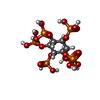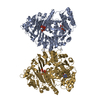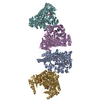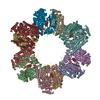+Search query
-Structure paper
| Title | Oligomerization-mediated autoinhibition and cofactor binding of a plant NLR. |
|---|---|
| Journal, issue, pages | Nature, Year 2024 |
| Publish date | Jun 12, 2024 |
 Authors Authors | Shoucai Ma / Chunpeng An / Aaron W Lawson / Yu Cao / Yue Sun / Eddie Yong Jun Tan / Jinheng Pan / Jan Jirschitzka / Florian Kümmel / Nitika Mukhi / Zhifu Han / Shan Feng / Bin Wu / Paul Schulze-Lefert / Jijie Chai /    |
| PubMed Abstract | Nucleotide-binding leucine-rich repeat (NLR) proteins have a pivotal role in plant immunity by recognizing pathogen effectors. Maintaining a balanced immune response is crucial, as excessive NLR ...Nucleotide-binding leucine-rich repeat (NLR) proteins have a pivotal role in plant immunity by recognizing pathogen effectors. Maintaining a balanced immune response is crucial, as excessive NLR expression can lead to unintended autoimmunity. Unlike most NLRs, plant NLR required for cell death 2 (NRC2) belongs to a small NLR group characterized by constitutively high expression without self-activation. The mechanisms underlying NRC2 autoinhibition and activation are not yet understood. Here we show that Solanum lycopersicum (tomato) NRC2 (SlNRC2) forms dimers and tetramers, and higher-order oligomers at elevated concentrations. Cryo-electron microscopy (cryo-EM) reveals an inactive conformation of SlNRC2 within these oligomers. Dimerization and oligomerization not only stabilize the inactive state but also sequester SlNRC2 from assembling into an active form. Mutations at the dimeric or inter-dimeric interfaces enhance pathogen-induced cell death and immunity in Nicotiana (N.) benthamiana. The cryo-EM structures unexpectedly reveal inositol hexakisphosphate (IP) or pentakisphosphate (IP) bound to the inner surface of SlNRC2's C-terminal LRR domain as confirmed by mass spectrometry. Mutations at the IP-binding site impair inositol phosphate binding of SlNRC2 and pathogen-induced SlNRC2-mediated cell death in N. benthamiana. Together, our study unveils a novel negative regulatory mechanism of NLR activation and suggests inositol phosphates as cofactors of NRCs. |
 External links External links |  Nature / Nature /  PubMed:38866053 PubMed:38866053 |
| Methods | EM (single particle) / EM (helical sym.) |
| Resolution | 2.84 - 3.6 Å |
| Structure data | EMDB-38679, PDB-8xuo: EMDB-38680, PDB-8xuq: EMDB-38685, PDB-8xuv: |
| Chemicals |  ChemComp-ADP:  ChemComp-IHP: |
| Source |
|
 Keywords Keywords | PLANT PROTEIN / tomato / helper NLR / dimer / tetramer |
 Movie
Movie Controller
Controller Structure viewers
Structure viewers About Yorodumi Papers
About Yorodumi Papers










